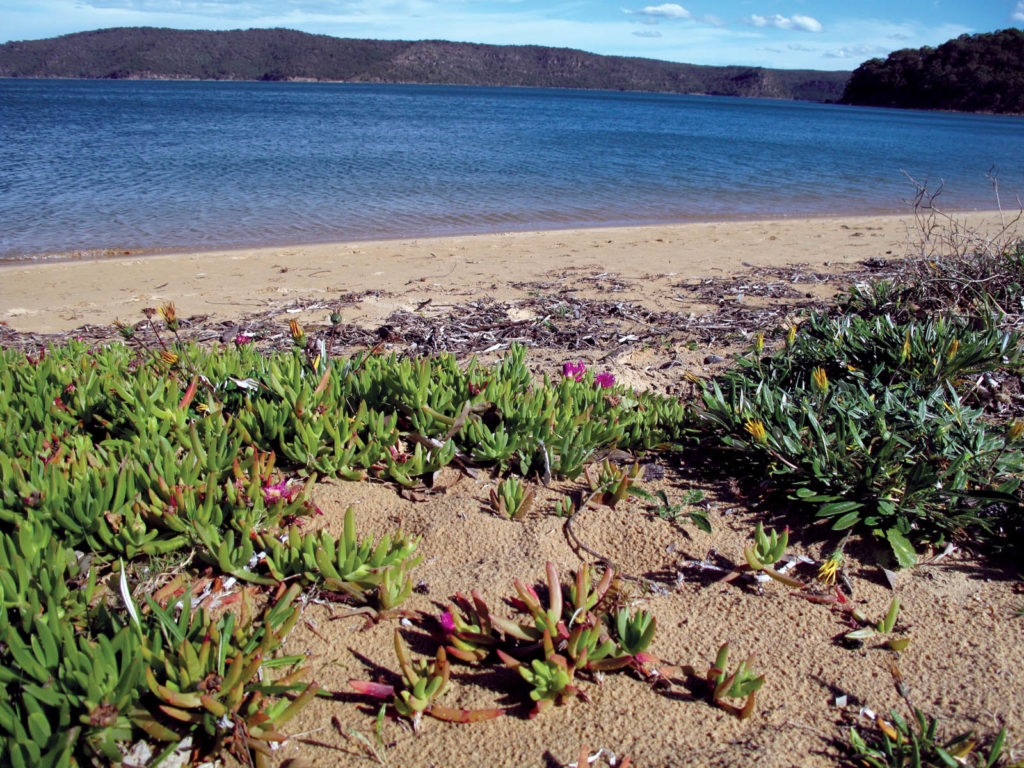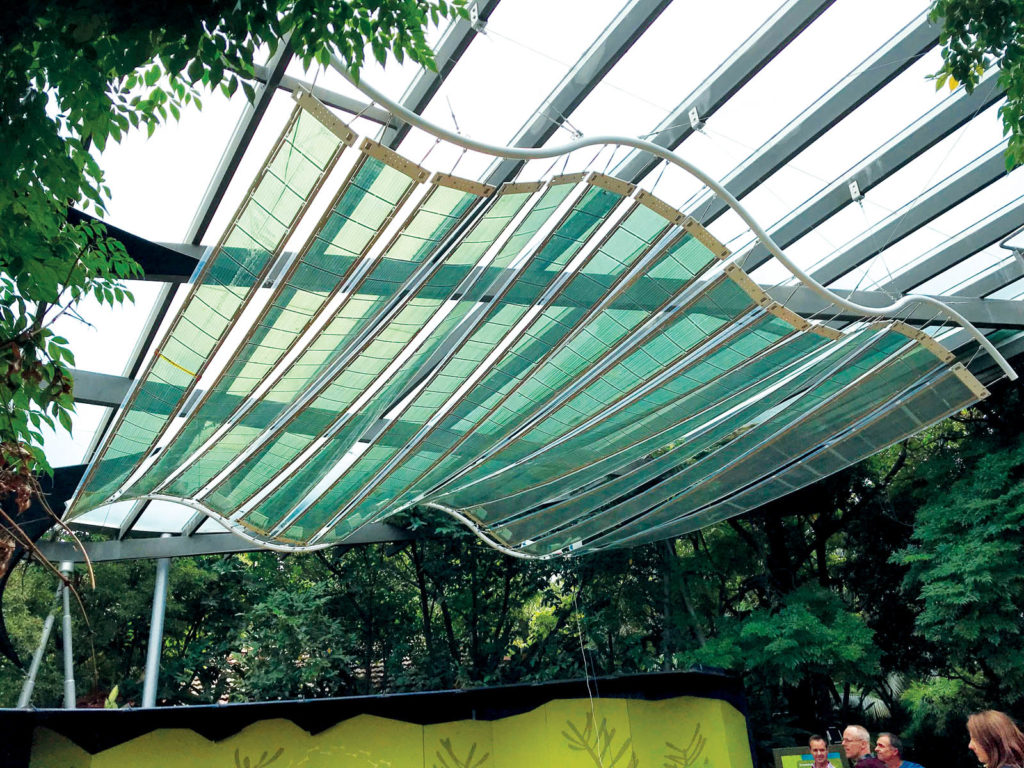Developments in geotextiles, renewable energy and recreation stem from Australia’s extreme environment.
By Marie O’Mahony
Australia’s geographic isolation puts the country and its technical textile industry in a novel position. The country is rich in natural resources, mining and exporting coal, iron ore, petroleum gas, zinc ore and other materials. The mining industry directly and indirectly puts pressures on the environment, with advanced geosynthetics helping to mitigate its impact. In its Annual Climate Statement for 2019, the Australian Bureau of Meteorology recorded the warmest and driest year on record, with significant heat waves recorded for the summer months of December and January. Harnessing solar energy is an area of intense research focusing on efficiencies, flexibility and scalability. The outdoor lifestyle in Australia has a strong focus on sports and recreation, with advanced and technical textiles driving innovation in apparel as well as larger-scale water-sports products.

Mitigating environmental impact
The bidim® nonwoven geotextile has a long track record of providing an engineering solution to land-erosion problems, such as weak soil, rutted and cracked roads, and liquid and gas leaks escaping from landfill sites. This last application has long been a challenge to monitor in a cost-effective and accurate manner.
The Australian manufacturer Geofabrics is now producing bidim C, the first commercial conductive geotextile made with graphene. The key advantage over previous systems is that it can be installed more efficiently with no wires involved and a simple overlap of the geotextile as opposed to skilled welding and specialized equipment.
The bidim C liner has been installed at a South Australia mine where there is a need to contain an aggressive level of wastewater. It is part of a system that consists of a chlorosulfonated polyethylene (CSPE) primary liner followed by a bidim A34C conductive geotextile, then a geocomposite drainage layer (or geonet) and a final compacted clay layer that functions as a secondary liner for additional protection. Another mining application has been in coal seam gas mining, where it is used in a brine waste tank. In this application, it saves design and construction time, as well as financial and environmental costs.
Coastal erosion is a consistent challenge in Australia, where geosynthetics are used to reinforce at-risk sand dunes and estuarine environments. With local branches throughout Australia, Global Synthetics manufactures ProTube Coastal Tubes, large bags made to contain sand and customized for specific applications in a range of sizes and reinforced with high seam strength. The geotextile tubes, bags or containers are part of a system that includes specialized filling and placing equipment so they can be filled, placed and stacked if needed in situ.
Geofabrics manufactures ELCOROCK® mega containers made from Texcel, a durable staple-fiber geotextile. The system ranges from hand-filled 88-pound (40-kg) containers to hydraulically filled 1,100-ton (1,000-tonne) mega sand containers and tubes. To ensure there are no weaknesses in the filled containers, a composite woven and nonwoven polyester fleece material may be needled into the woven scrim and a recessed double-chain stitch may be employed to withstand the abrasive action of the ocean.

Renewable energy
Hybrid organic-inorganic perovskite solar cells are showing increasingly high levels of efficiencies, rising from about 3 percent in 2006 to more than 24 percent in 2019, according to the U.S. Office of Energy Efficiency and Renewable Energy. Achieving manufacturing scale for commercialization is proving a challenge that researchers at the Commonwealth Scientific and Industrial Research Organisation (CSIRO) are looking to address. CSIRO is the Australian federal government agency responsible for scientific research including renewable energy.
The deposition method commonly used in laboratories is spin coating. Adapting the method for industry, CSIRO has developed a small-scale slot-die coater that can deliver a precise amount of material to the substrate as a noncontact deposition. Researchers identified an issue around cracks and pinholes appearing in the coating and printing of electroactive layers. These can significantly lower the efficiency of the solar cells. To address this, CSIRO has developed a patented polymer-based additive to reduce the cracks and pinholes remaining in the electroactive layers of perovskite solar cells.
Taking another approach, researchers led by Paul Dastoor of the Centre for Organic Electronics at the University of Newcastle in Callaghan, Australia, in partnership with the Commonwealth Handling Equipment Pool (CHEP) Australia, are entering into large-scale trials of conventional printing processes for the production of flexible organic photovoltaics (OPVs). Tiny particles of mixtures of different polymers are turned into a suspension in water that can then be used to coat large surface areas. In addition to the efficiencies of production, there is considerable weight savings—developers estimate as much as 300 percent less than conventional solar cells. This would make them ideal for applications on architectural membranes and emergency tent shelters.
From a manufacturing point of view, using existing technology is a bonus, as much of the printing business has been lost to cheaper overseas companies.
“The sun provides us with many times the energy we need every day—we just don’t use it,” Dastoor says. “We are focusing on using up stored sunlight in the form of coal or oil. Our ability to dig something out of the ground and utilize it is diminishing rapidly.”

Sports in challenging conditions
Achieving speed and agility in harsh weather conditions is an essential part of sailmaking. International sailmaker North Sails uses 3Di™ technology to produce sails for superyachts and the Volvo Ocean Race teams.
In 2016, Thomas Coville set the sailing single-handed around-the-world record of 49 days, covering 28,400 miles (52,000 km) during the journey, using a 3Di mainsail. The 3Di technology is based on a spread-filament construction, in which the fiber reinforced with a set resin is the structure rather than a laminate that carries the additional weight of a material substrate. Being able to add and reduce weight with precision has great benefits in racing.
“If we can reduce the weight up high, then we’re making massive gains,” says Dave O’Connor, an Australian 18-foot skiff sailor, speaking about 3Di RAW™. “The biggest factor in increasing our performance is being able to reduce the weight of the sails.”
On land, Victoria, Australia-based POD Active specializes in joint protection for athletes. The company has developed a knee protector for motorcyclists called Unbreakable K8 that uses military-grade carbon-fiber sheets. These are pressed, and then heated and molded to optimize strength while keeping the weight low in the forged carbon composite. To reduce abrasion and increase overall wearer comfort, a patented Human Motion® technology engineers “synthetic ligaments” using high-strength Vectran Fibres™.
Increasingly, geographical regions are individually developing particular strengths in the technical textile sector. There are a number of factors that can account for this. As seen in the example of Australia, these factors can range from climate and environmental impact, to industrial needs, to regionally specific sports and recreational requirements. These developments in turn drive market innovation at a global level, moving the industry forward.
Marie O’Mahony is an industry consultant, author and academic. She is the author of several books on advanced and smart textiles published by Thames and Hudson and is a visiting professor at the Royal College of Art (RCA), London. www.linkedin.com/in/marie-o-mahony-94776836
SIDEBAR: Textiles around the world
With few exceptions, the textile industry functions as a world market. However, regional strengths and challenges afford a unique perspective that steers research and development along a particular trajectory. Tools and equipment may be universal, but the experiences and circumstances of the researchers and developers are not. In the case of Australia, geographical isolation, an extreme enviroment and the outdoor lifestyle of its inhabitants drive textile innovations.
 TEXTILES.ORG
TEXTILES.ORG


